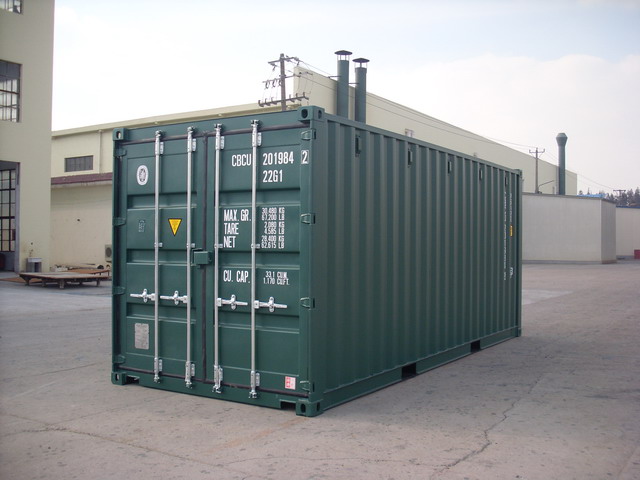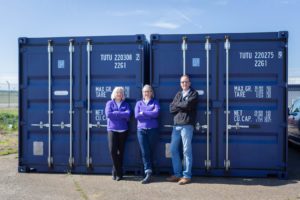
Last Updated on January 18, 2024
Where are shipping containers built?
The vast majority – around 95% – of new shipping containers are built in China. Like with many industrial and commercial products, China offers cost-effective labour rates. The raw materials used in the construction of sea containers are often much lower in China than in any other country.
Containers are produced in other countries, but if you see a shipping container on the back of a lorry, on a ship or being used as storage it will almost definitely have been built in China.
As with many modern products the sheer number of containers being built in China means that Chinese producers have not only the most experience in building containers, but arguably have the most refined and perfected methods of manufacture.
Our factories in China predominately build sea containers for shipping. The demands of sea freight requires that any container used for shipping should be dry, clean, watertight and secure. Building shipping containers to match these demands makes them ideal for several secondary uses, most importantly secure storage.
Shipping container specifications
Shipping containers are designed to be ‘in cube’. This means that no feature or function of the container should protrude from the external perimeter of the clearly designed box shape of the container. This includes door handles, which should sit flush with the top and bottom rails of the container.
The tight specifications of shipping containers ensures that they can be placed securely on ships, but also makes them ideal for customers who wish to use more than one container for storage in a location where space is limited.
The cargo-worthiness of a container is regulated and ensured by a convention called Container Sage Convention (CSC). All shipping containers must have a CSC plate to be considered fit for purpose. A container’s CSC plate is usually found on the outside of the left front door of a container.
A CSC plate is to containers what a passport is to people. Container surveyors look for CSC plates and test containers to ensure they are capable and safe to carry cargo. Sea containers carrying a CSC plate are certified as being able to carry a cargo of up to 30 tons.
Driving down the cost of buying new shipping containers
As mentioned previously buying a Chinese-made shipping container is advantageous for a number of reasons in terms of build quality and cost-effectiveness of manufacture. Another advantage of buying a Chinese container is that they are shipped from China. This may seem an obvious fact to raise, but the truth is that if a new container travels from China to the UK with a cargo it dramatically lowers the purchase cost. Our ‘new’ containers are sometimes referred to as ‘once used’, ‘one trip from China’ or ‘used once from China’. The cost of buying a new container that has carried a cargo once from China is much lower than the cost of buying a new Chinese shipping container that is shipped from China empty. If we offered containers that had never been used the transport costs would be high, to the point of being cost-prohibitive, and uneconomical.
Shipping lines buy new containers to reflect demand
Shipping lines and leasing companies buy new shipping containers to meet demand. The ‘correct’ time to buy is decided upon in a different way for each organisation. Many shipping lines and leasing companies order at the same time, which then causes a problem with ‘supply and demand’. When the factories have larger orders, this can often drive the price up. Equally, when they don’t have many orders, the price goes down. During the recession in 2007-2009 we found the standard 20ft new shipping container price went to over £2,000 plus VAT each. Since Brexit in 2016 the price for a new 20ft container rose again and in May 2017 the price of a new 20ft container was around £2,000 plus VAT each. These prices will reduce as the factory order books get lower, however, this will take quite some time to reduce to a level not seen since 2015/2016. Just imagine a container is just like a nugget of gold or a piece of silver. The container is a commodity that rises and falls in value just like any other commodities.
How new is new?
Some container suppliers will class a sea container as being ‘used/second hand’ when it has been used for commercial shipping for ten to fifteen years. The shipping lines and container leasing companies often decide how ‘old’ a container is when the decision is taken to sell them on.
However, we bring in genuinely new (once used) containers because our customers prefer the cleanliness and aesthetics of once-used containers.
New shipping containers – what to look for
Because new shipping containers are transported from China they may accrue some minor marking and dents. The rigours of loading, unloading, port movement, ship loading, train transport and road haulage inevitably has an affect on all new containers. But containers are built to be tough and resistant to these physical challenges.
However, when buying a new container there are a number of factors that need to be taken into consideration.
- There will be minor dents and scratches
- Sometimes there will be some marking on the flooring of a new container
- Above all a new container should be structurally sound, watertight and aesthetically tidy.
Every shipping container is thoroughly checked by experienced staff at our depots before being transported to our customers. Our top priority for every container sold is to exceed our customers’ expectations.
In a world where there is always someone who will supply containers cheaper, we supply better value containers at a more cost-effective price.
Ready to find out how cost effective our new shipping containers are?
Click here for a fast quote…
About Jane Billing
Jane Billing has over 30 years’ experience in shipping container supply. During that time Jane has gained a very broad knowledge of the whole shipping container industry. From construction, to shipping, to adaption and conversions, if you have a question about any aspect of the shipping container industry Jane will likely have the answer for you. After many years working for some of the biggest names in the shipping container industry Jane set up her own company, Billie Box Ltd, in 2012. Since launching, Billie Box Ltd has sold well over 1500 new and used containers.







